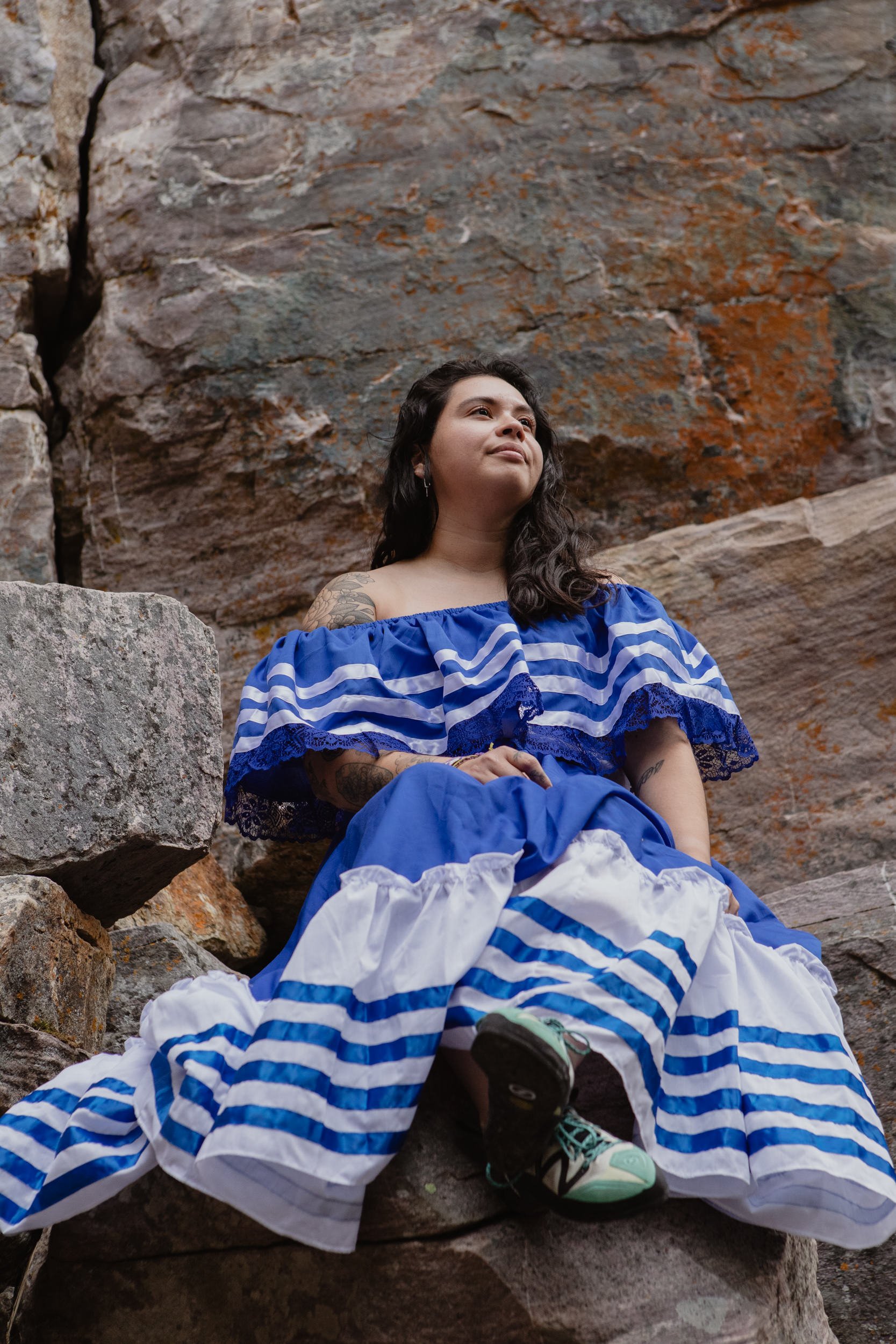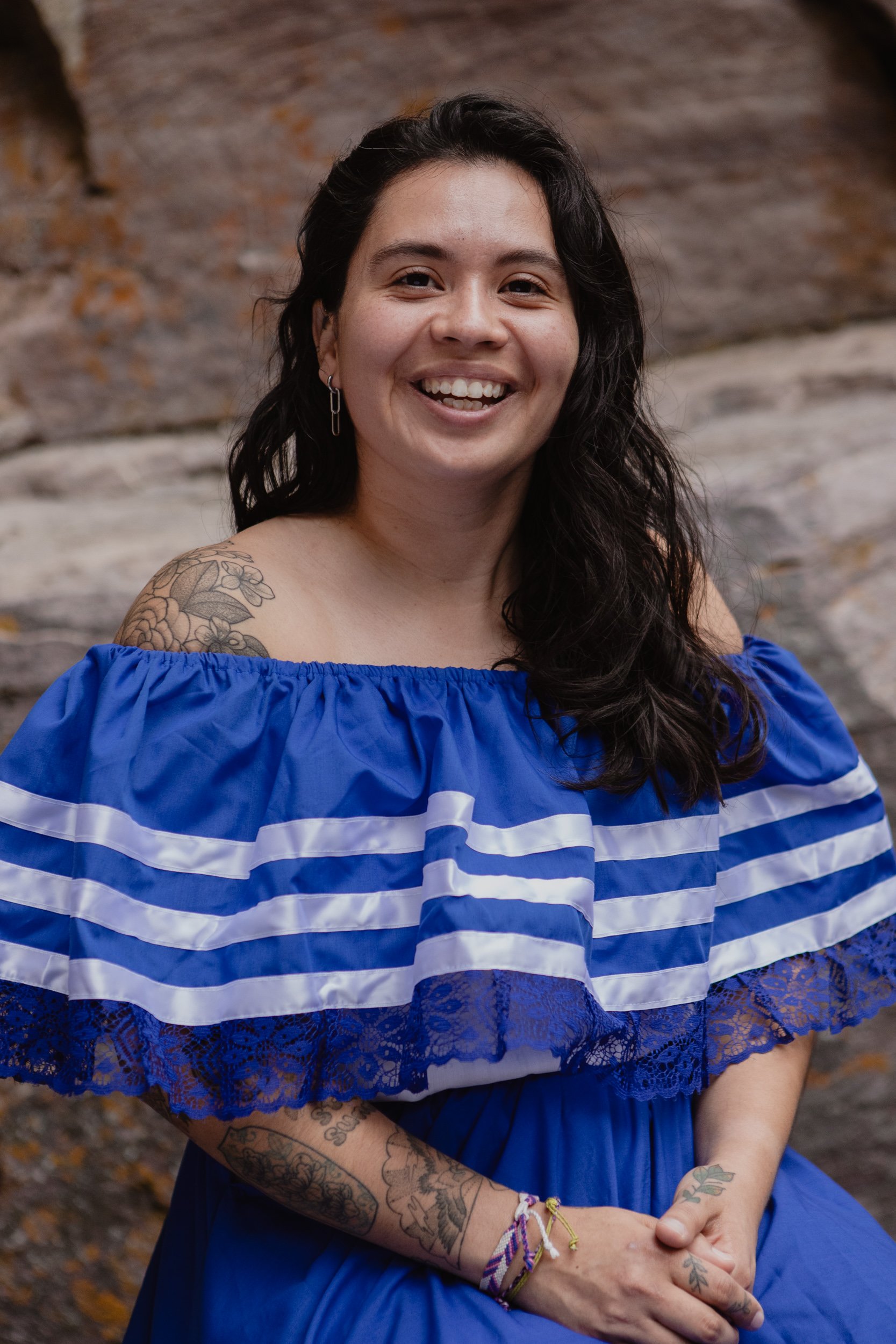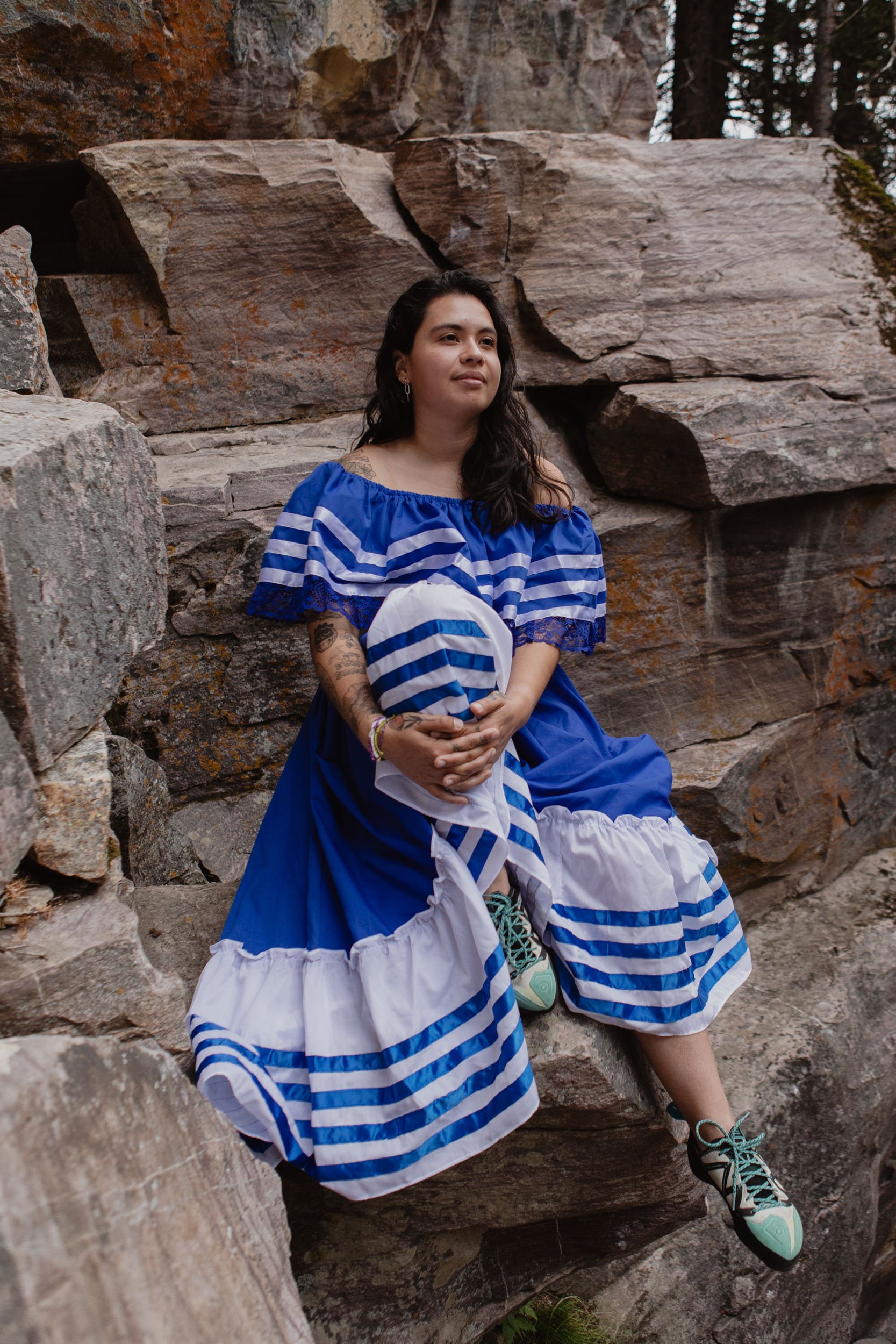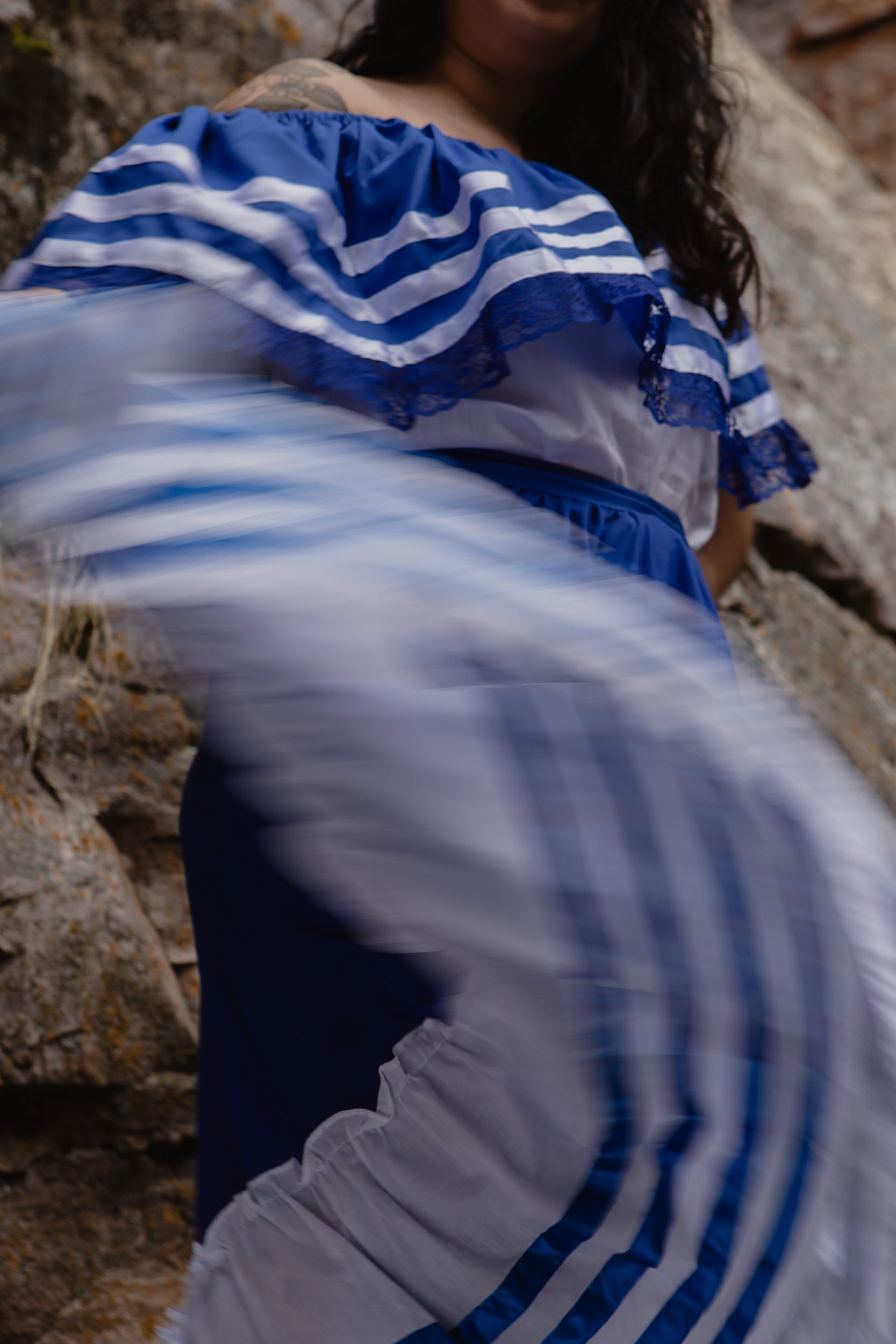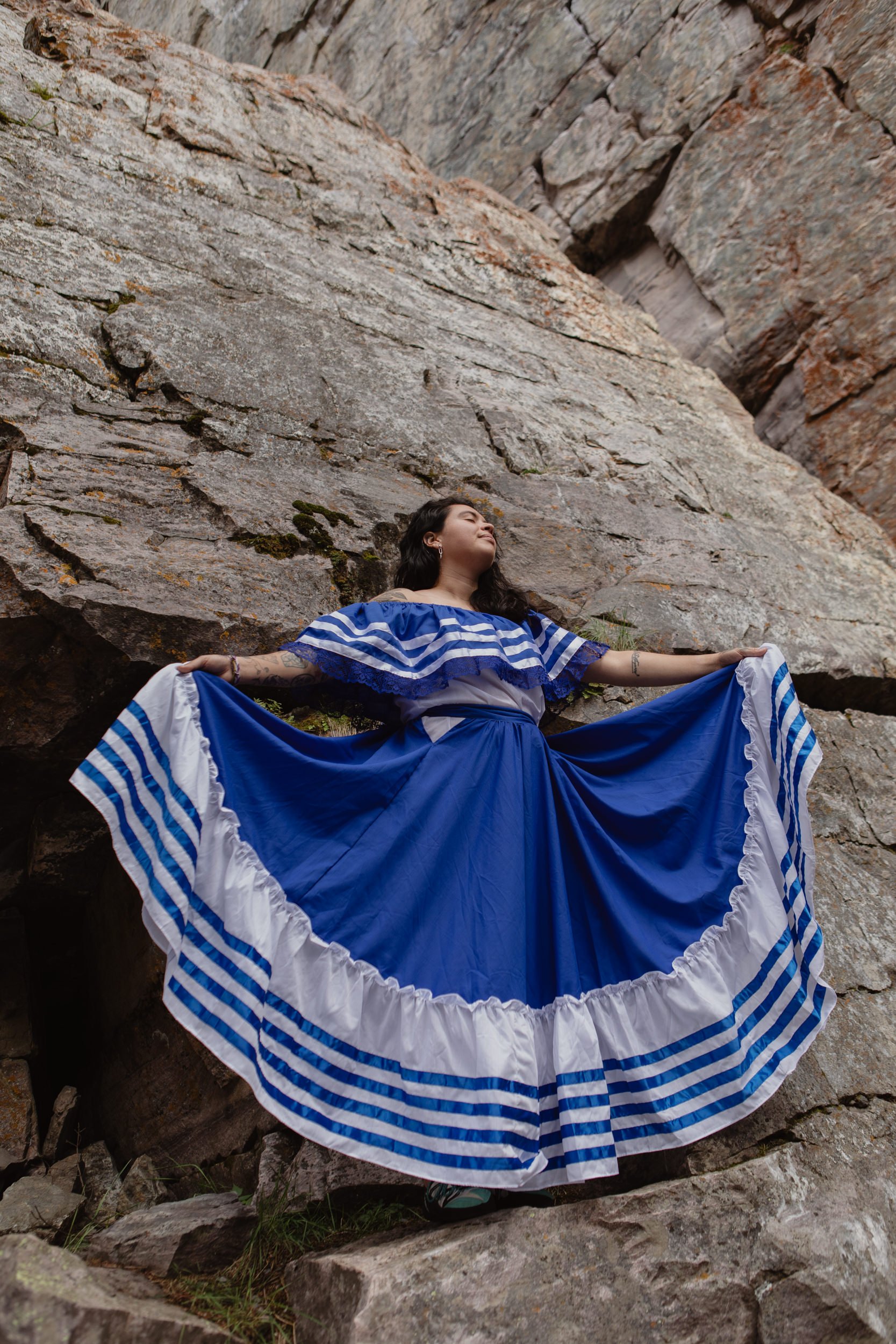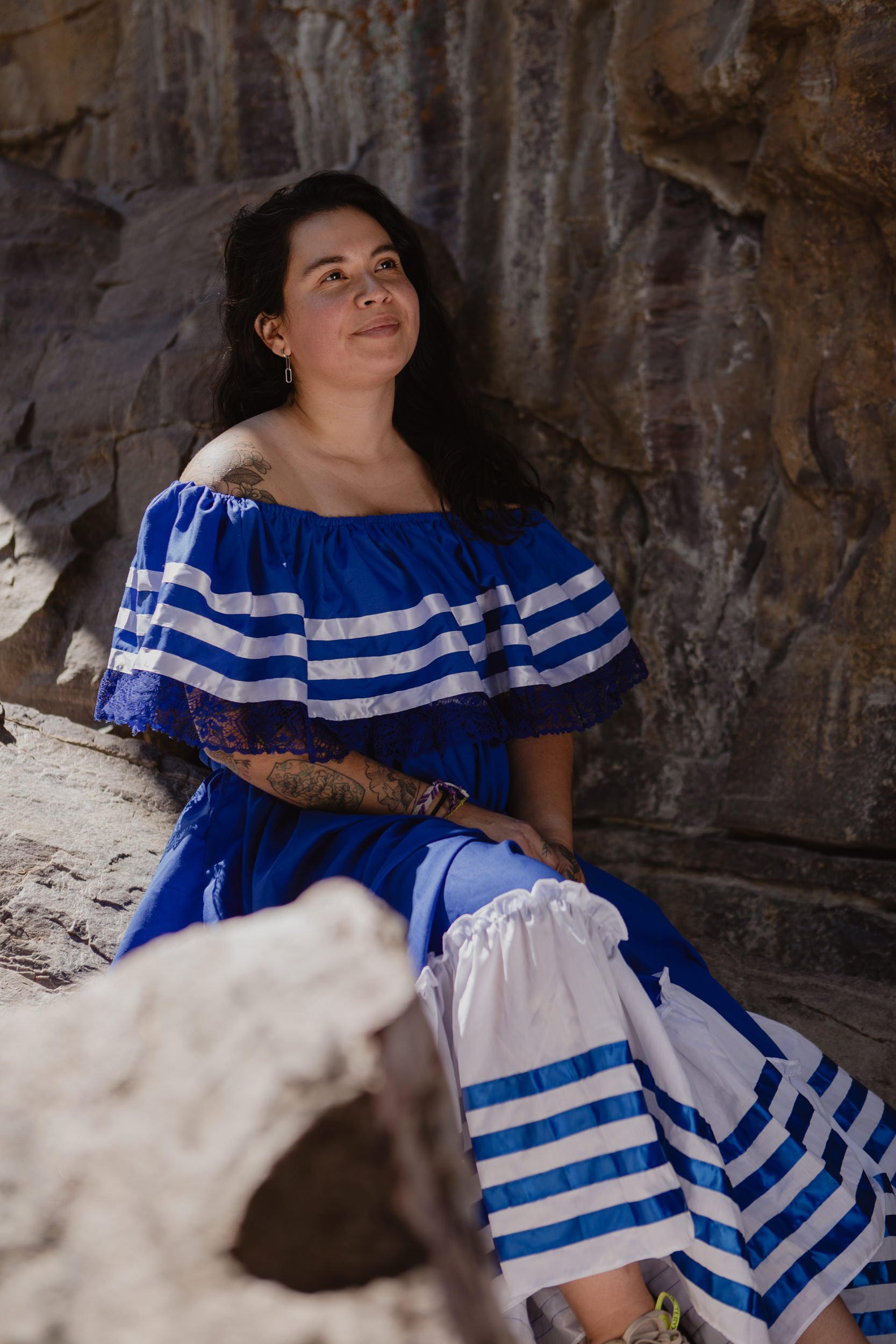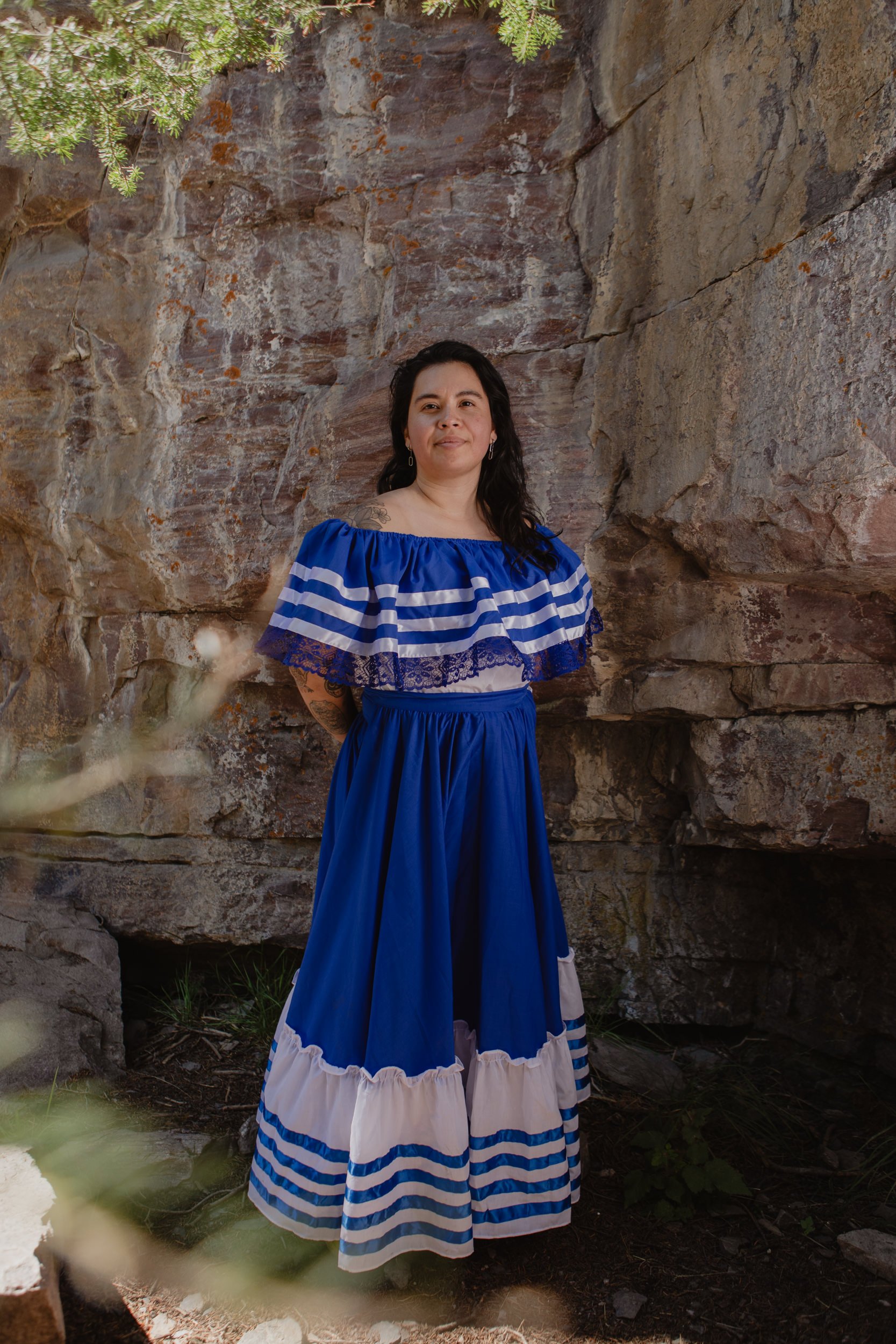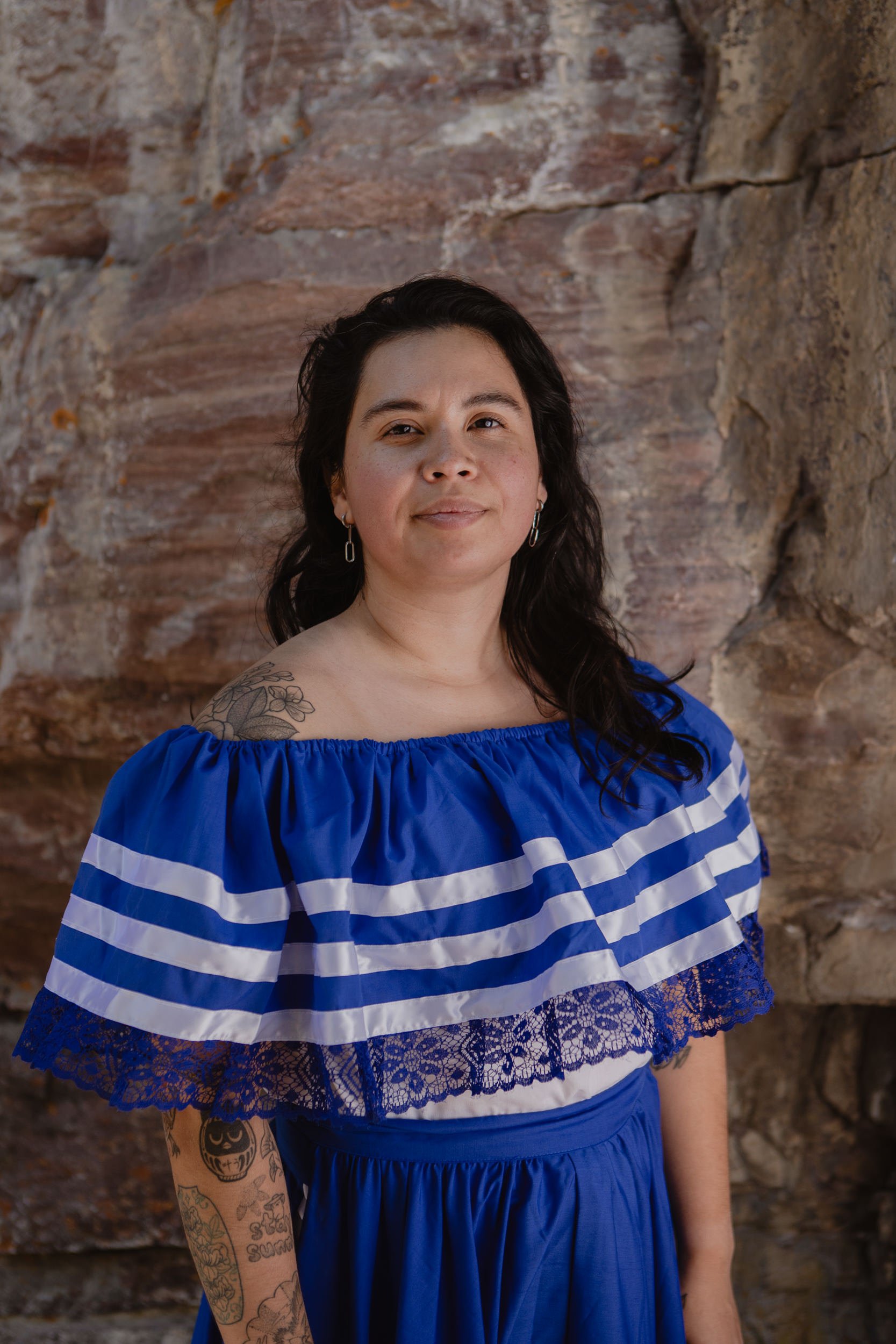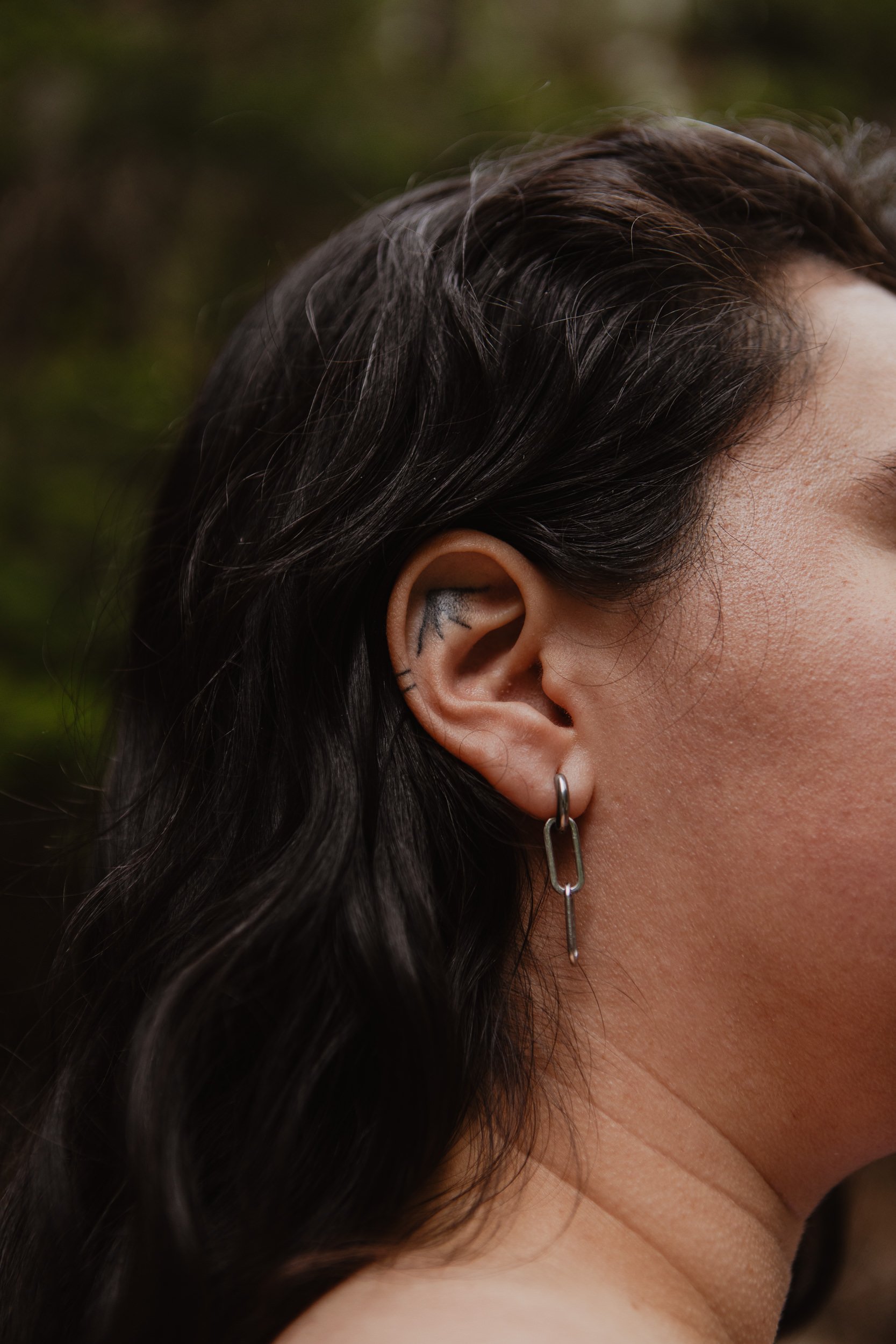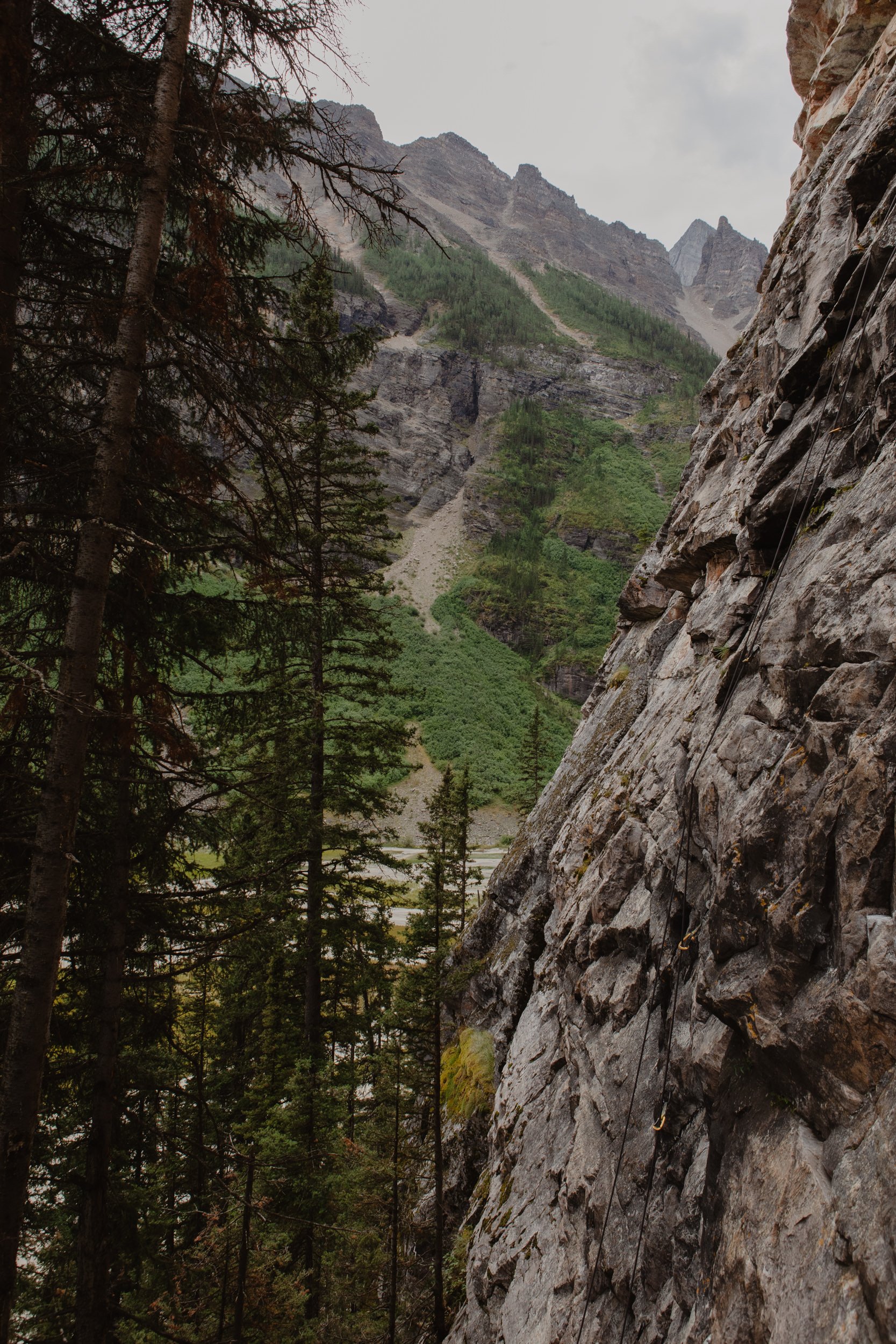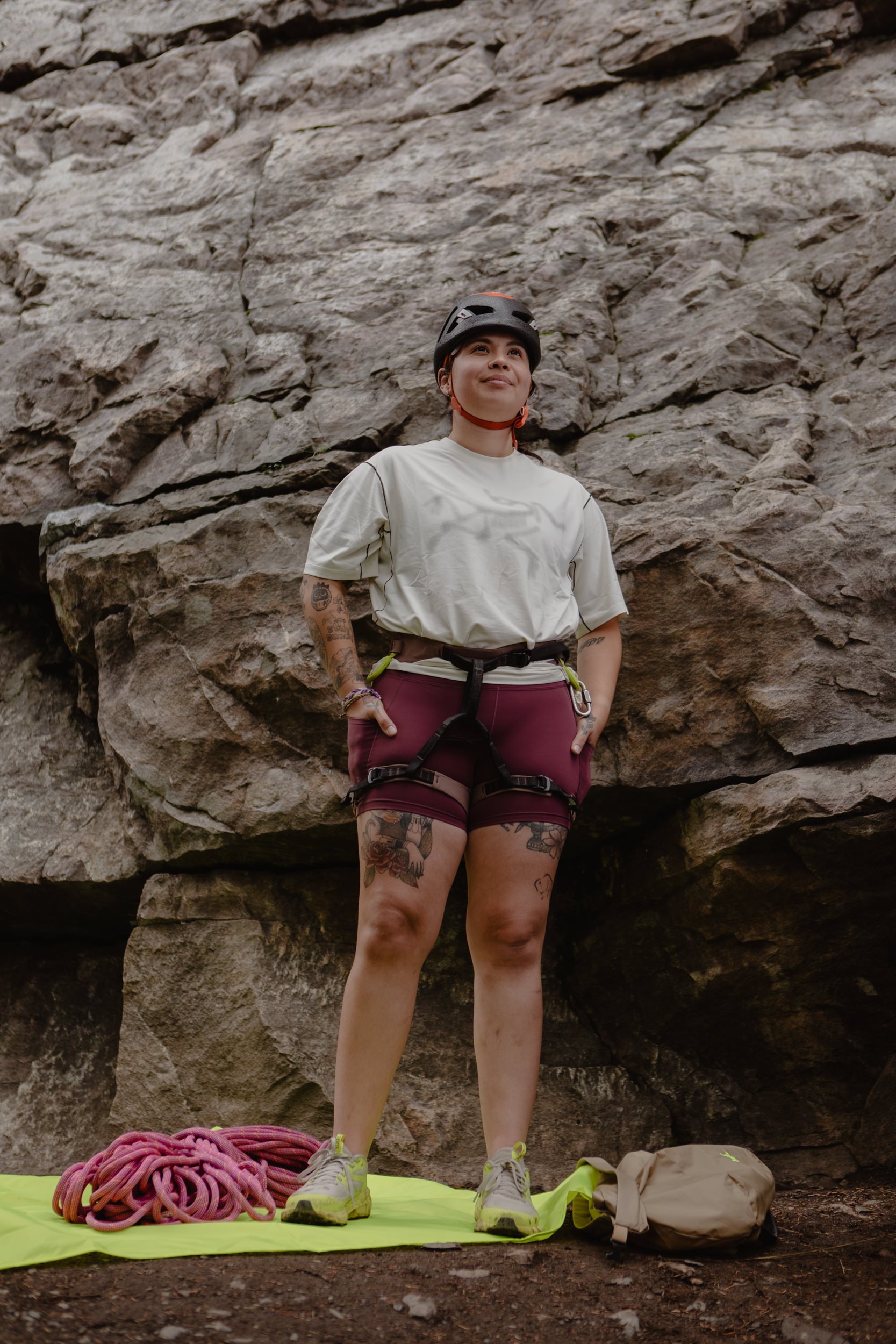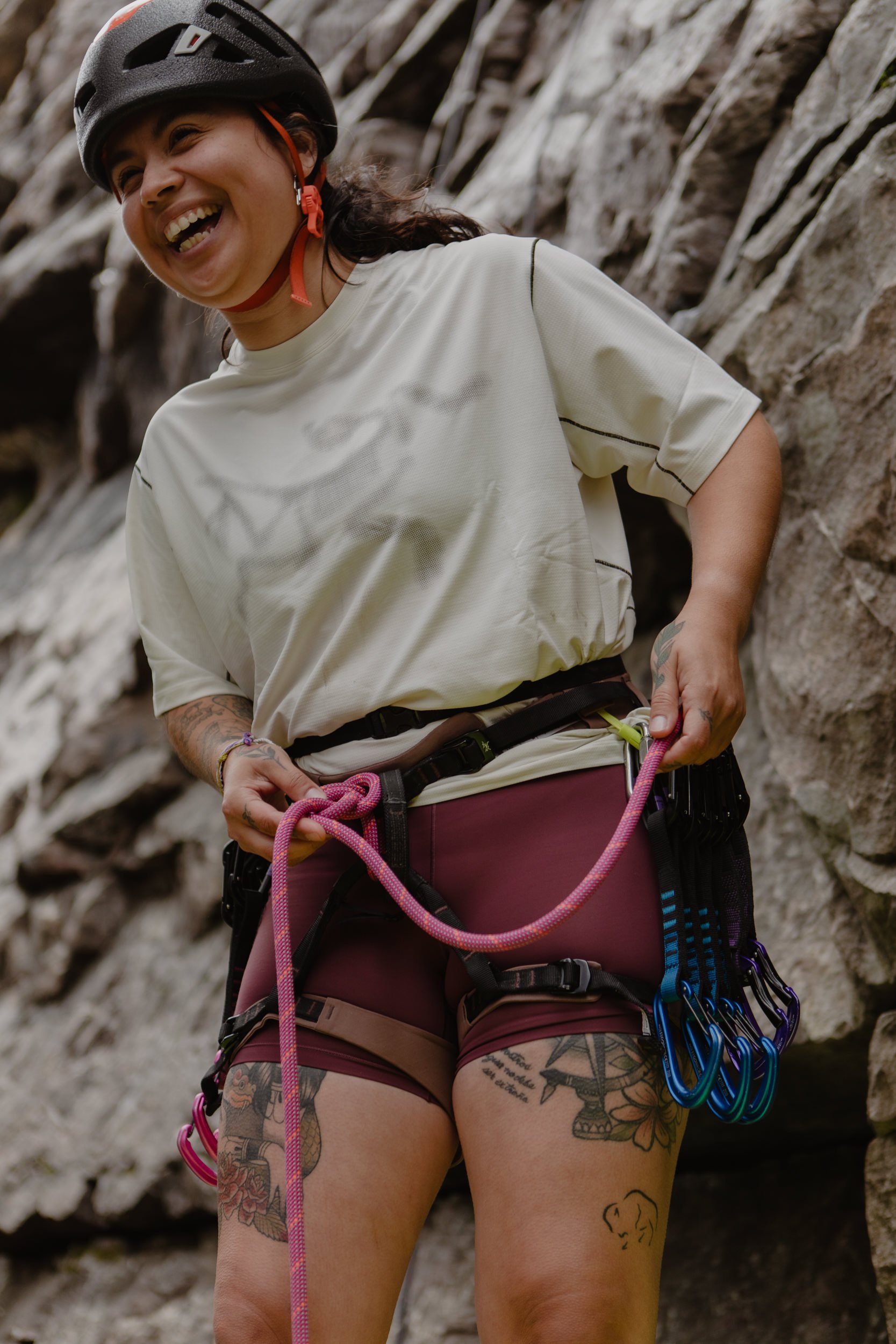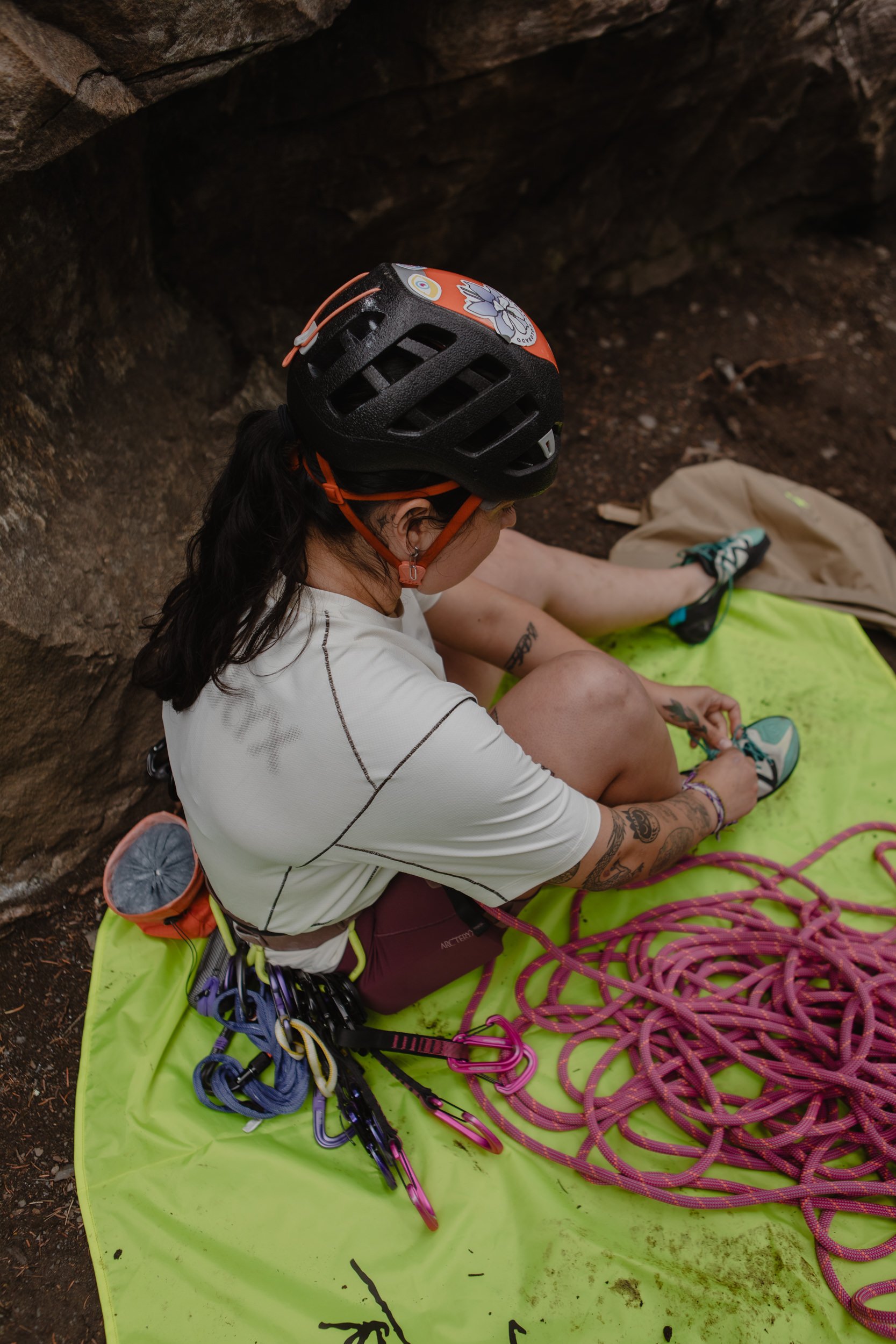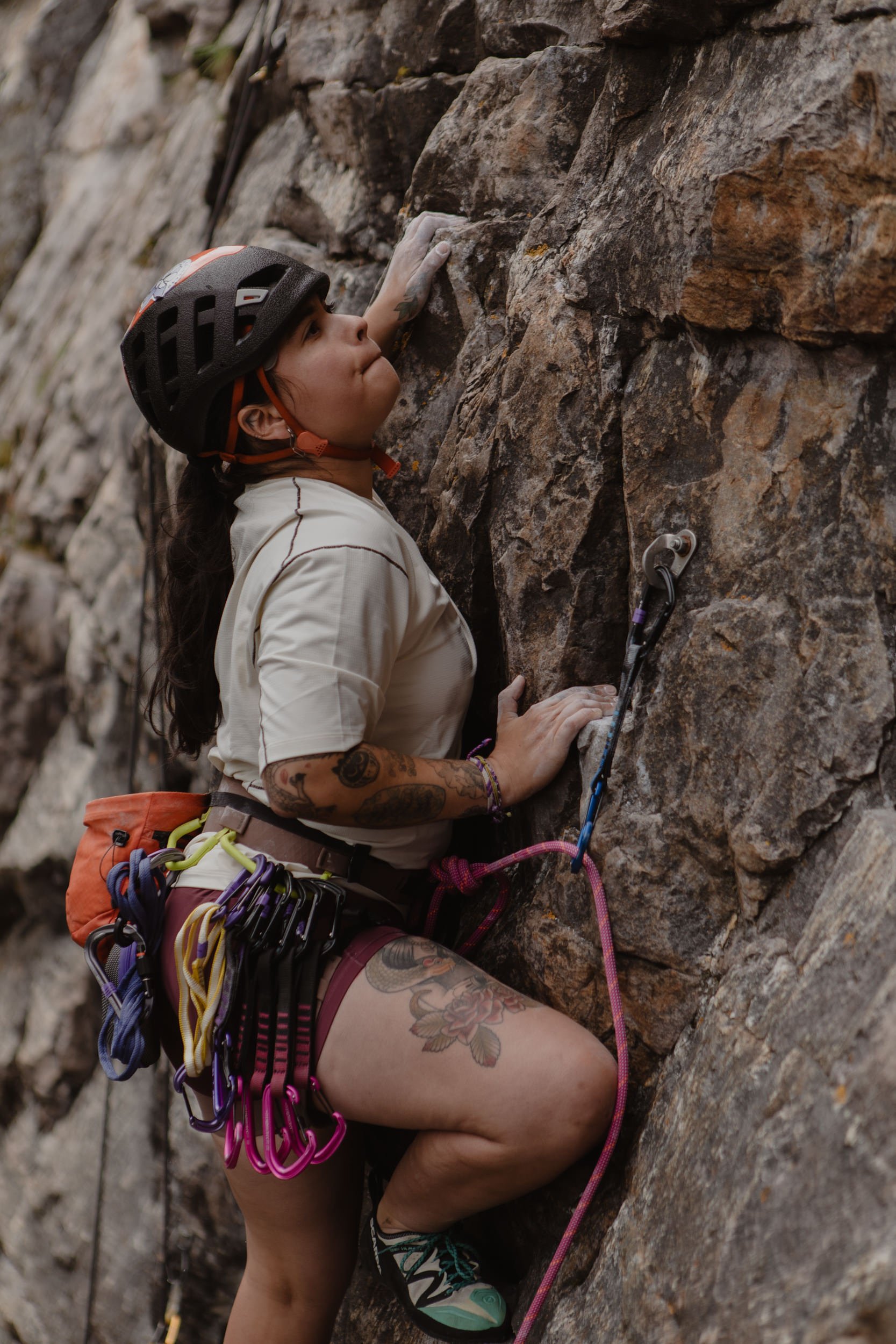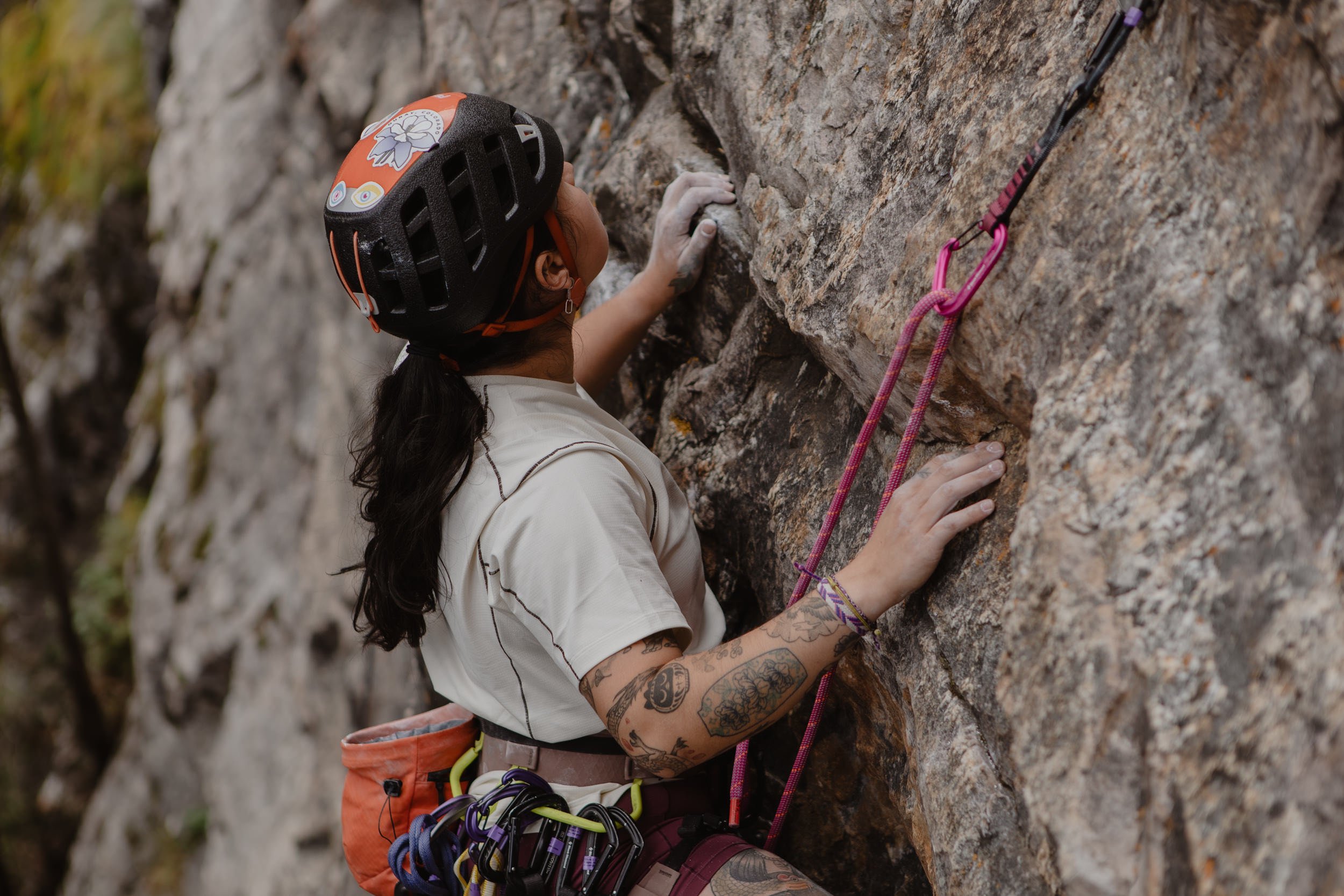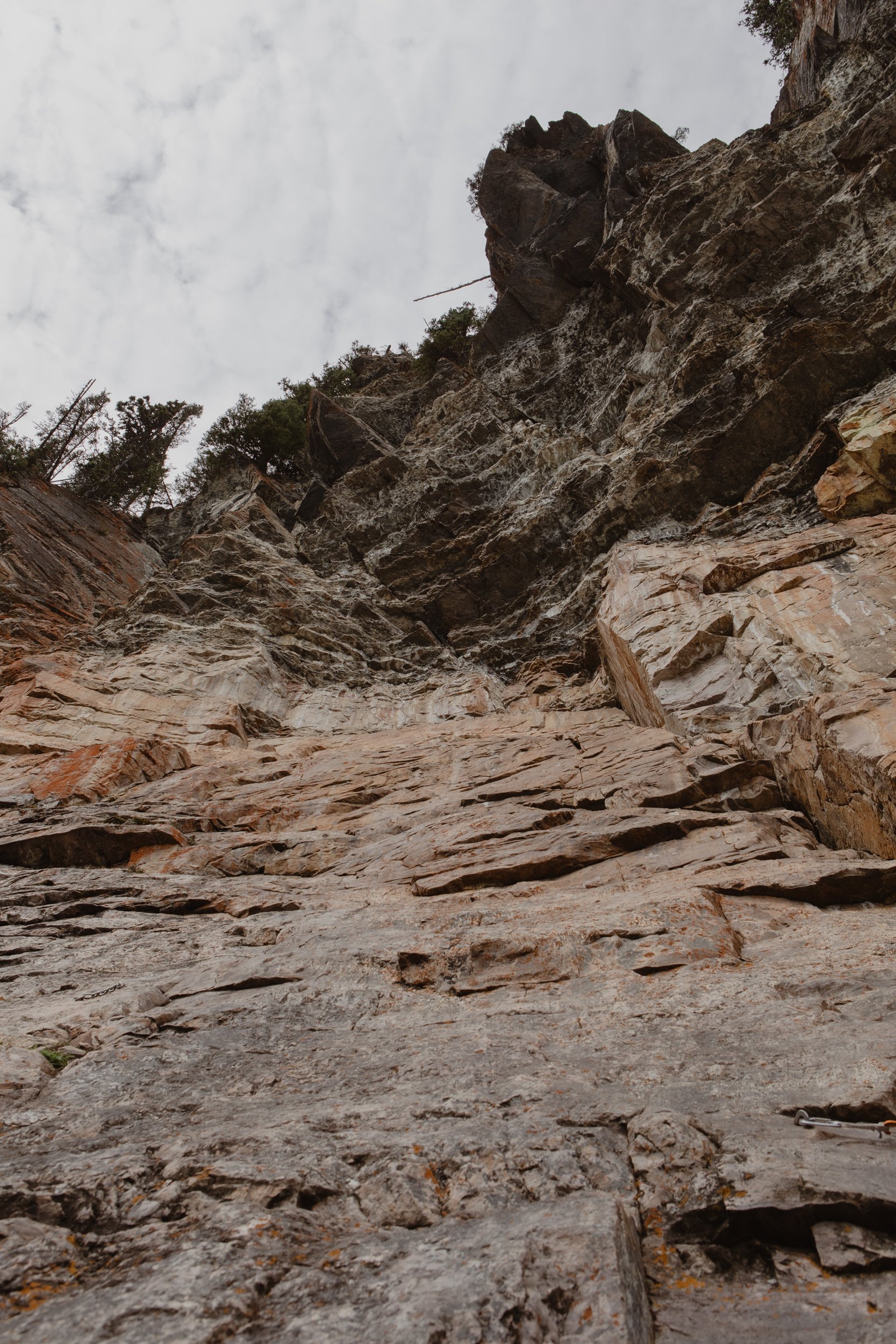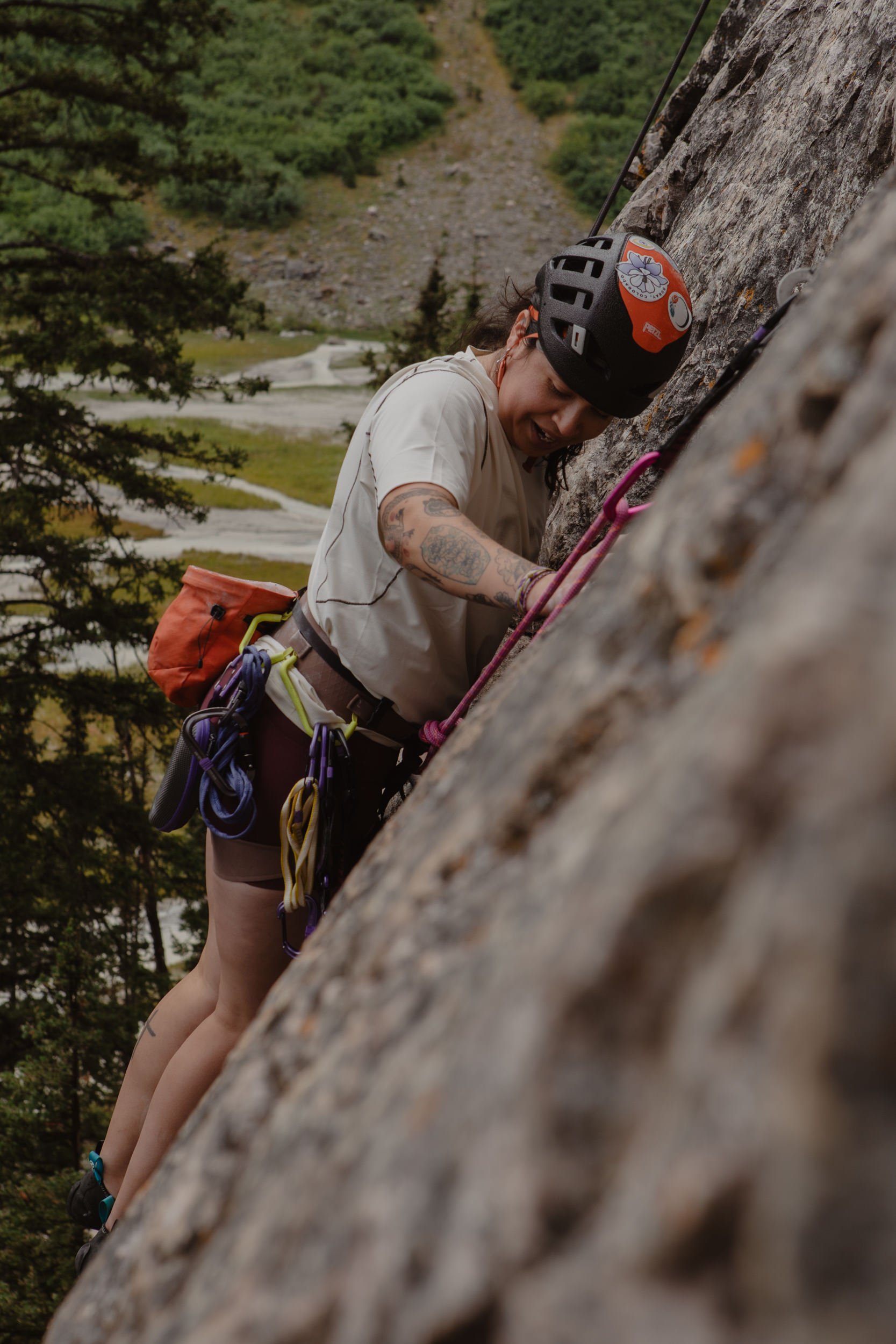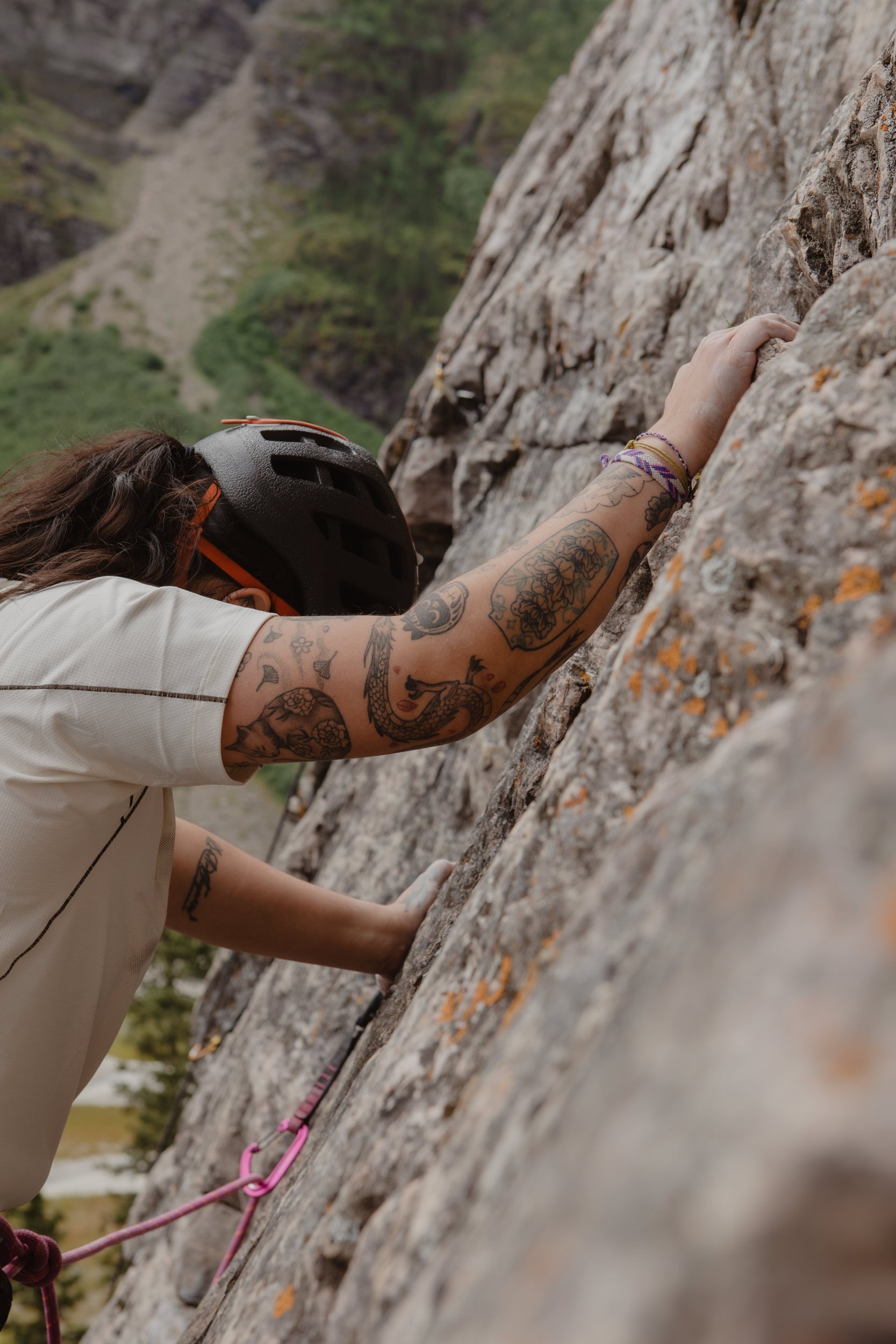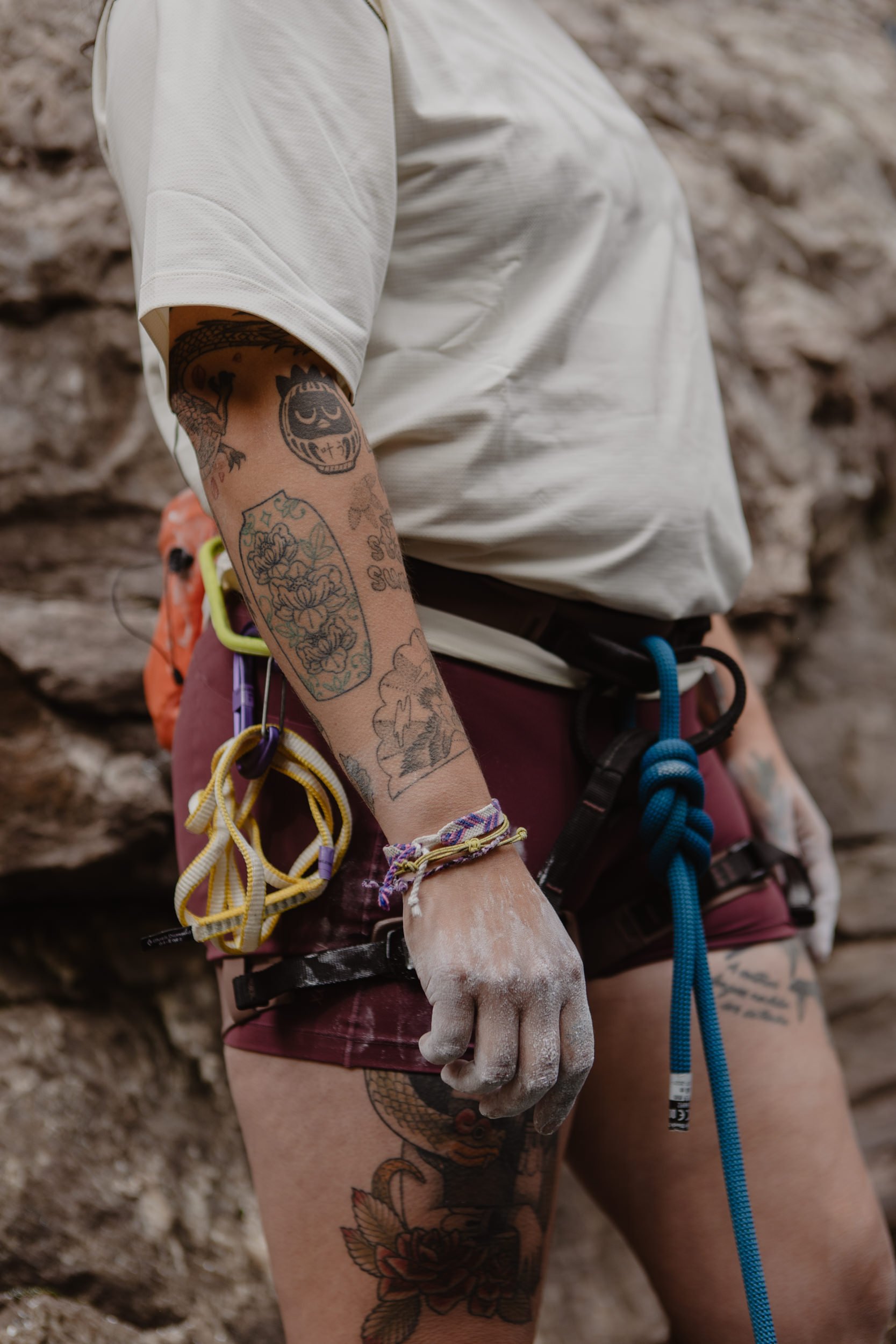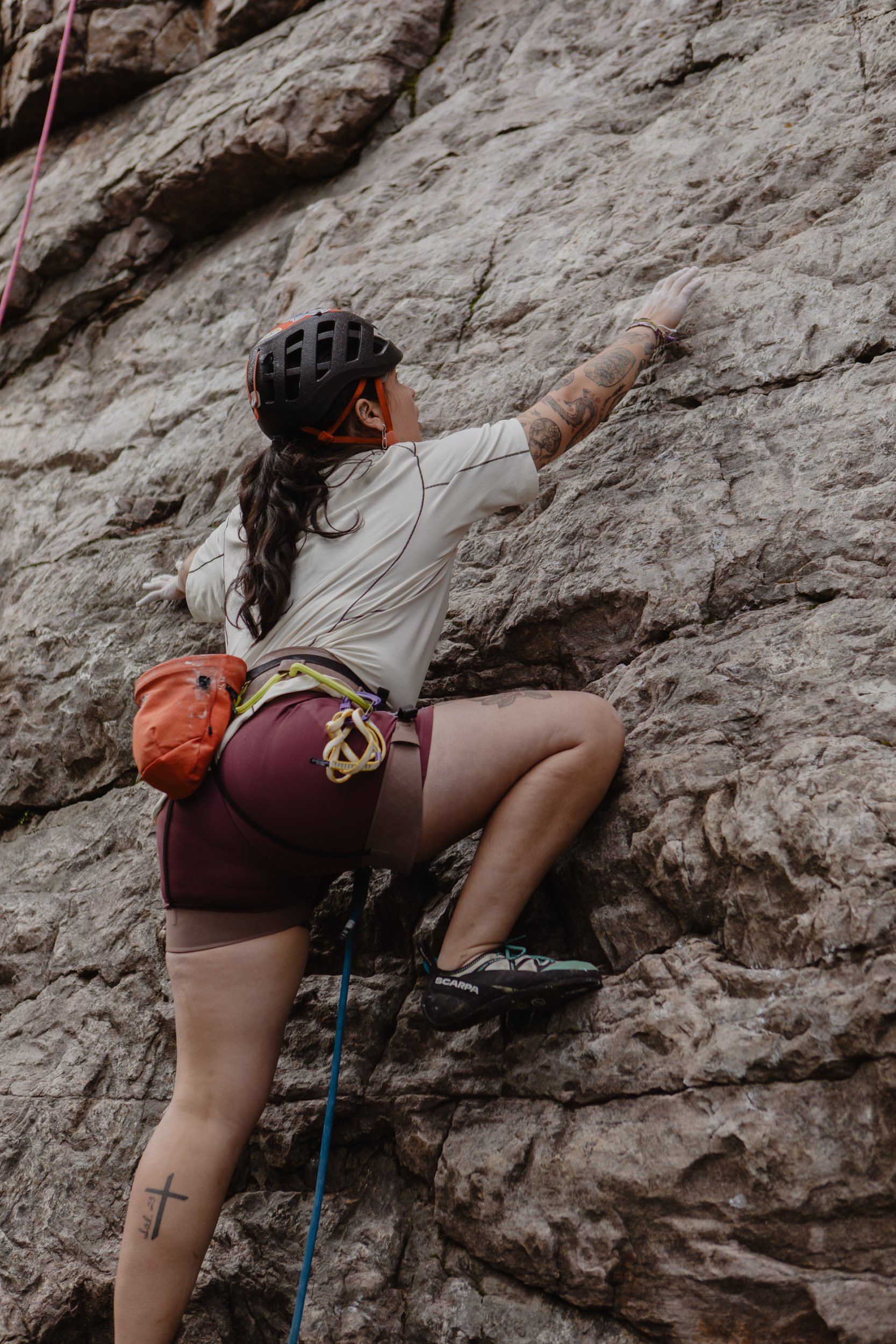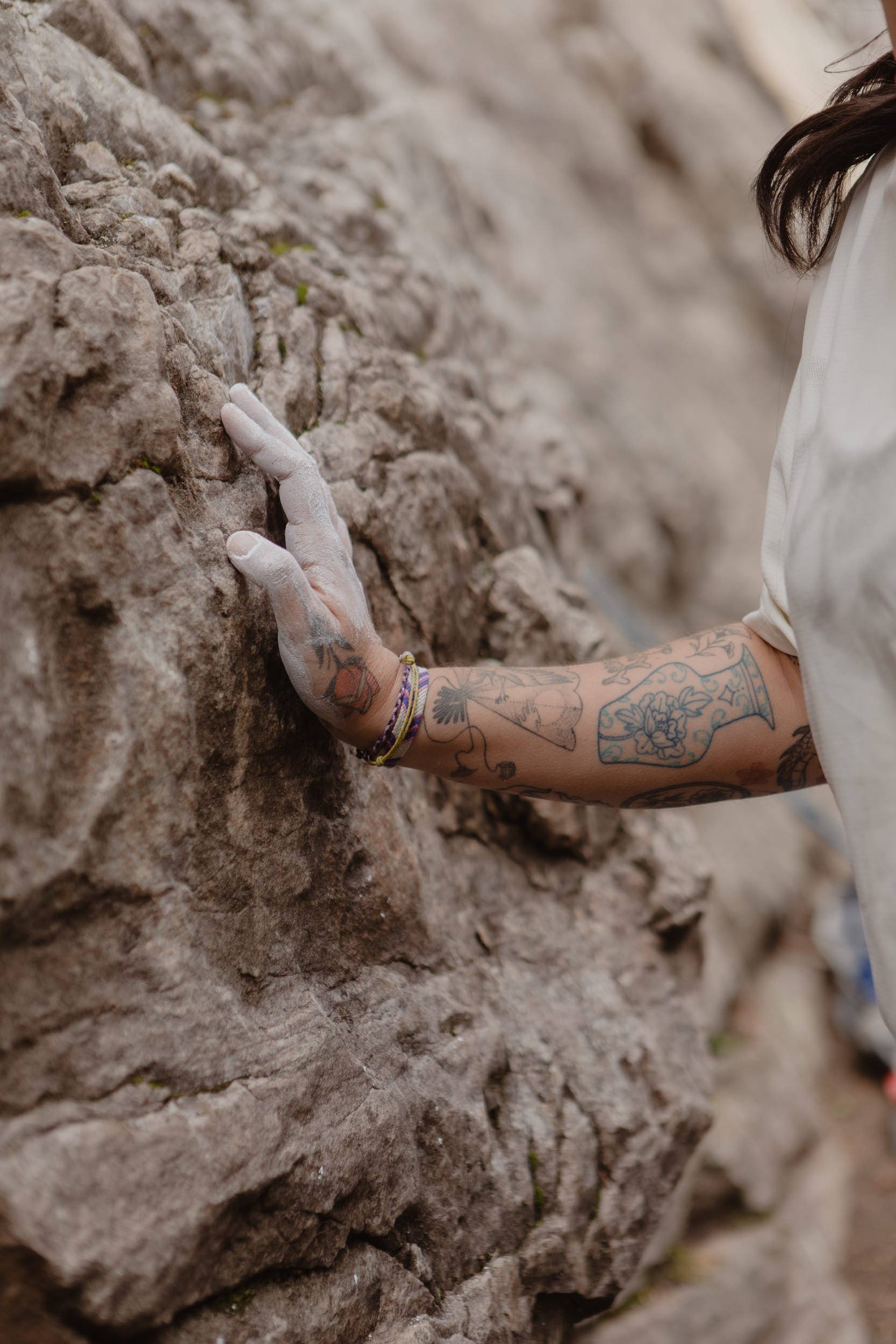Coralia.
Coralia (she/her), a Latina-Canadian climber wearing a trencilla, a traditional Nicaraguan dress.
Coralia is a climbing instructor and elementary school teacher based out of Calgary. She is also Vice-President of Soul of Miistaki, (miis-dah-gee, meaning mountain), an organization founded by Blackfoot woman & climber Cassie Ayoungman. Soul of Miistaki offers the BIPOC community an earlier introduction to outdoor sports, breaking barriers to access, fostering connection and healing, and promoting representation in activities that are situated on the traditional lands of the Indigenous people in Treaty 7 territory.
I photographed her at the crag early one Saturday morning. Here is her story.
Tell us about your upbringing and early life.
I was born and raised in Winnipeg. My family came from Nicaragua as refugees, so I grew up with humble upbringings. I didn’t get to grow up with many options to pursue sports or recreation activities due to money, and it wasn't exactly a priority for women to participate in sport from a cultural lens either. When I was 14, our family moved to Calgary. As a 14-year-old, I felt devastated by the move, mid-puberty, new schools, new friends. I was not stoked.
In what way has your cultural heritage or upbringing influenced who you are today?
My ethnic heritage is Latinae and I'm mestiza ( European / indigenous). My cultural and racial background was something that I had a weird relationship with as a kid/teen. I was from neither here nor there. Too brown for the western world, too gringa ("foreign") to be Nicaraguan. So I felt the need to prove I could be both.
Luckily, my parents really felt it was important that we knew where we came from, so growing up, we would spend almost every summer in Nicaragua with family. This meant having to learn Spanish, having exposure to our cuisine, political landscapes, history, dance, etc. Growing up, I felt pretty well versed as to where I came from and why my parents had to leave. Having the opportunity to spend time in Nicaragua showed me compassion; my family still struggled back in Nicaragua. This created a sense of gratefulness for my opportunities in Canada, but also a sense of internalized pressure to make my parents’ immigration worthwhile. All these factors felt chaotic internally. I was always questioning why I got treated differently.
As an adult, I'm better equipped and no longer feel the need to externally validate my ethnicity and racial identity as much as before. I am Latina, I am mestiza, I am Canadian, and that's just it. It doesn't matter whether I went to Nicaragua or not. It doesn't matter whether I speak Spanish or how I speak Spanish. As far as being Canadian, I'm that too—it's reflected in my values of women being independent, as well as knowing how to dress for winter (haha).
What led you to climbing? Do you prefer ice climbing over regular climbing (if so, why)?
Oh boy, climbing. In short, a relationship led me to climbing. I was dating someone who was really into it. One day I asked them to show me what it was about, because I saw them spending so much time doing it, and out of care and love I wanted to know what drove them to the sport. I quickly found out why. I discovered that climbing was scary, but very unique.
Unlike other activities I had dabbled in, I had to really concentrate. The added level of “the extreme” as well as being safe forced a sense of focus. Outside thoughts couldn't poke in anymore—you have to stay dialed. That was such an attractive piece of the sport. I started indoor climbing before rock climbing and in the last two years or so, I've developed skills for ice climbing.
Weirdly, I think I prefer ice climbing over rock climbing. As a short human, I enjoy the ability to protect the ice how I want and when I need to. There's also something very interesting about the fact that ice changes; temperature and seasons affect the difficulty and terrain, which makes it a delicate sport. There's something about that that I find beautiful.
What is an aspect of your identity that you feel at home in?
I feel at home in being a woman. I think it’s where I had the most flexibility growing up, especially in Canada. I got to be "tomboy" despite cultural norms from family. I was still allowed to be rugged when I dressed up on Sundays. Friends and peers never minded that I enjoyed playing rough and that I had very forward personality. For me, I had the privilege of having versatility and openness in exploring my own personal femininity and masculinity.
Although my parents occasionally hoped for a more feminine appearance, they never criticized my more masculine clothing choices. This was a stretch for them, and I appreciated their support. However, when we visited extended family, their outward criticism of the liberties my parents granted me was evident. Despite cultural norms of "air kissing" when meeting people, my parents respected my discomfort and allowed me to opt out in situations where I felt uneasy. My parents raised me to be an outspoken woman. This became a point of contention with my extended family, as they believed I should conform to expectations.
Reflecting on these experiences, I now realize the importance of those choices. The dress I wear in these images represents my ability to embrace traditional femininity if I choose, while also expressing my authentic self. It symbolizes the blending of cultures in my life—the warmth and vibrancy of my Latin heritage combined with the individualism I've embraced as a Canadian. Moreover, the dress connects me to my Nicaraguan Indigenous roots, offering a glimpse into a time when our nation maintained a relationship with its indigenous heritage, even as these traditions sadly wane in present-day Nicaragua.
What is an aspect of your identity that you struggle with?
I struggle most with my queerness. I'm only out to my friends and social circles. However, my family isn't aware of this. For my own mental health, I have chosen not to inform them of this yet. So, from a safety perspective this the most challenging aspect of my identity at the moment. It's also the newest. As a woman of colour I didn't explore or express this side of me for many years because I wanted to avoid further discrimination. To say the least, this is still a journey for me, but I'm pretty happy to be on this journey and feeling more like myself thanks to the support of friends and community.
Tell us about the dress.
I know it as a trencilla dress; trenza means braid. Typically, women’s hair is up in two braids and then tucked upwards and ribbon gets braided into the hair to match the dress. This style is often used for dancing to marimba music. The colours of the dress change depending on the song one is performing to, sometimes. But this one is the colour of the Nicaraguan flag and can be used with many songs.
The significance of the dress is closely tied to a newfound understanding of womanhood. Growing up, I enjoyed the freedom to challenge gender norms within my friendships, school community, and even at times with my family. While I often embraced a tomboyish style, I also felt comfortable expressing my femininity. This sense of feminine freedom allowed me to connect with others emotionally, fostering deep relationships.
What are you most proud of?
I am proud to be a teacher and instructor. I am so jazzed to be part of so many people's lives and it's an outlet for me to be supportive and develop community. I've been a teacher for 3 years and a climbing instructor for about 2 years. It brings me so much joy to work with youth and see them become themselves, find their voices and to create space for them. As a climbing instructor, its much the same—I get to create opportunities for folks from different backgrounds to access the sport in a safe and inclusive way. That way folks can explore this sport without experiencing the same challenges I faced when I started climbing.
What is something you are aiming towards in the next few years?
I want to find more consistency and independence in my climbing abilities. I want to push my own personal boundaries and be more confident as a climber, and shed some of the traumas and hangups I still have with the sport. Someday, I'd like to be an assistant outdoor rock guide.
Why are these portraits important to you?
These portraits hold incredible significance for me. As someone who often grapples with imposter syndrome, looking at these images allows me to observe myself from an external perspective, a vantage point that is typically elusive. In these portraits, I encounter not only my own image but also a reflection of strength, happiness, and beauty, accompanied by a tangible sense of confidence. The emotions they evoke are so powerful that they had me teary, serving as a poignant reminder to perceive myself through this positive lens more frequently.
I recognize myself as a spirited individual, akin to a vibrant firecracker, and it brings me immense joy to witness this aspect captured visually. The contrast between my tattoos and the dress becomes a visual metaphor for the interplay between tradition and modernity. Additionally, the striking opposition of the brilliant white of the dress against the sombre, moody backdrop of rock mirrors the same dichotomy within me—the radiant joy that stems from enduring challenging experiences.
These portraits are truly transformative, offering me a precious opportunity to appreciate my own resilience and vitality in a way that I will carry with me moving forward.
